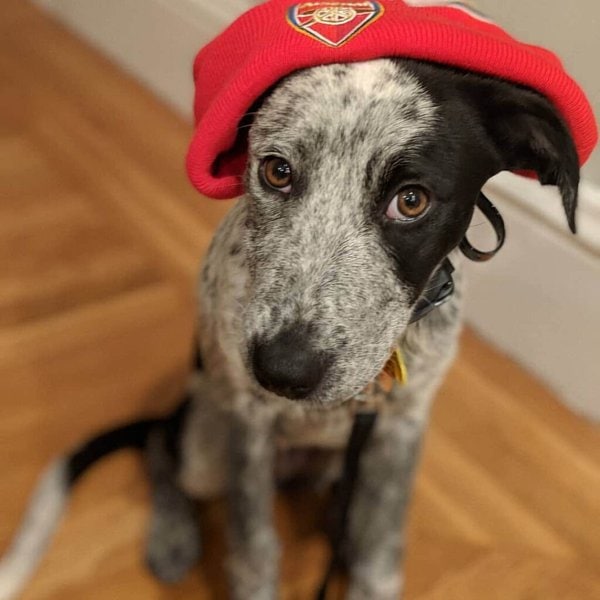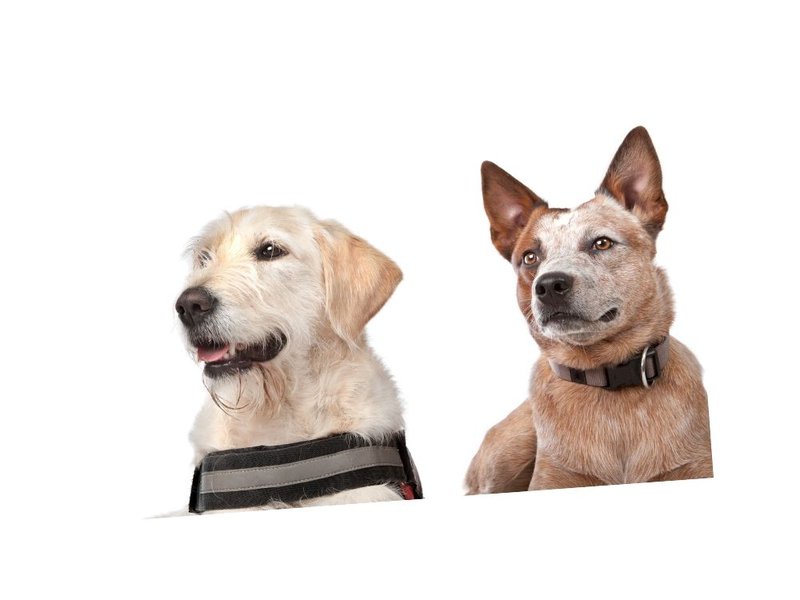Are you an active person looking for a loving and affectionate dog that will make a great exercise partner? If this sounds like you, you should go for the Labrador Blue Heeler Mix.
So, what is a Labrador Blue Heeler Mix? The Labrador Blue Heeler Mix is a lovey dog breed that is the result of crossing the Labrador Retriever with the Australian Cattle Dog, which is commonly referred to as the Blue Heeler. The mix is a highly active, intelligent and very loyal pooch.
Before heading out to the nearest rescue center to adopt a Blue Heeler Lab Mix, however, it is good to first gather information about this dog breed so that you know what to expect once you bring the doggie home. In this guide, we’ll go share all the important information you need to know about the Labrador Blue Heeler Mix. Before getting into that, let’s first learn what a Labraheeler is.
What Is A Labraheeler?

The term Labraheeler is another word that is used to refer to the Labrador Heeler Mix. The Labraheeler brings together the playfulness and high energy of the Blue Heeler with the friendliness of the Labrador Retriever.
Appearance
The appearance of the Labraheeler can take after that of either parent, or fall in between the appearance of both parents. For instance, a Labrador Blue Heeler pup may have either the folded ears of the Lab, or the upright pointed ears of the Blue Heeler.
Most Blue Heeler Lab Mixes will have a lean and athletic body. This is because both parents of the Blue Heeler Lab Mix have working dog origins.
Size
A dog’s size in adulthood will affect how suitable the dog is for you, so this is something you need to know from the onset. So, how big do Lab Blue Heeler Mixes get?
Labrador Blue Heeler Mixes will have a big variance in size, owing to the size differences between the Lab and the Blue Heeler.
A Labraheeler can weigh as little as 35 lbs, or as much as 80 lbs. Similarly, they can be as short as 17 inches, or as tall as 25 inches at the shoulder.
The best way to determine how big a Labraheeler will get is to look at the size of both parents.
Coat
Like its parents, the Labraheeler has a double coat, which makes this pooch a heavy shedder. The Labraheeler will typically have a multi-colored coat, with the blue-colored speckles of the Blue Heeler intermixed with the Lab’s solid colors.
How Long Do Labraheelers Live?

The Blue Heeler has a life expectancy of 12 to 16 years, while Labs live for about 10 to 12 years. With proper nutrition, mental stimulation and exercise, you can expect your Labraheeler to live for about 12 to 16 years.
While designer dogs are usually healthier than their purebred parents, your Labrador Blue Heeler Mix might still be susceptible to health conditions that affect the Lab and the Blue Heeler. Some of the common health problems among Blue Heeler Lab Mixes include:
Progressive Retinal Atrophy
Progressive Retinal Atrophy is a term used to refer to a group of hereditary conditions that results in the gradual degeneration of the retina. Left untreated, this condition will eventually leave your canine buddy totally blind.
Fortunately, it is possible to have the puppy you’re interested in tested for the condition before you sign the papers.
Osteochondritis Dissecans
Osteochondritis dissecans is another genetic condition that affects a dog’s bones and joints. A dog with condition will experience abnormal growth of cartilage in regions like the knee, hip, or elbow. This condition is common among Blue Heelers.
Patellar Luxation
This is a condition that leads to dislocation of your dog’s kneecaps. In less severe cases, it is possible for your pooch to live comfortably with the luxating patella, without any sign of discomfort. In extreme cases, however, the condition can lead to lameness.
Other Health Problems
Other problems that the Labrador Blue Heeler Mix could be susceptible to include joint problems like hip and elbow dysplasia, deafness, and entropion.
How Much Does A Labraheeler Cost?

Buying Cost
Cost will have a major influence on your decision to get a pet, so this is something you are definitely curious about – how much is a Blue Heeler Lab Mix?
While the Labraheeler is a designer dog breed, they are just starting to get popular, and therefore, their prices have not yet been exaggerated. When buying from a reputable breeder, you can expect the Labraheeler puppies’ price to fall between $500 and $1,000.
The good thing with getting your Blue Heeler Lab Mix puppy from a reputable breeder is that it allows you to get information about the pup’s family tree, and if possible, meet the pup’s parents.
Meeting the parents and getting information about the pup’s family tree is the best way of gauging the pup’s future temperament, health, and size.
Whether you’re acquiring your pup from a rescue center or a breeder, it is also advisable to have the pup undergo a medical checkup so that you’re certain that the pup is totally healthy.
Other Costs
Buying a pup is like buying a car or adopting a child. When calculating the cost of acquiring your new furry buddy, don’t forget to factor in the costs associated with raising the pup.
Remember to factor in the costs of things like dog food, grooming products and supplies, toys and treats, kennels or crates, medical expenses, leashes and collars, and so on.
You should also factor in the cost of other things like training and socialization, pet licenses, pet insurance, and so on.
Are Labraheelers Good Dogs? Temperaments Of Labrador Blue Heeler Mixes
Labraheeler Temperament
The Labraheeler comes from two great dogs that have amazing temperaments. Therefore, you can expect your Blue Heeler Lab Mix to be an affectionate and loving pooch who will be extremely loyal to you and the entire family.
Labraheelers are also very protective, something that is inherited from the Blue Heeler side of the family.
High Energy Levels
Both the Labrador Retriever and the Blue Heeler are active, working dog breeds, and therefore, the Labraheeler is an equally high energy dog. If your family does not have an active lifestyle, you should forget about keeping this dog, because the Labraheeler requires lots of physical activity.
With this dog, a leisurely walk around the block will not suffice. The Labraheeler needs activities that are physically intense, such as going on long hikes, obstacle courses, swimming, or playing games like tug of war or fetch.
This means that the Labraheeler will not fit well in an apartment. They require homes with large yards. Failure to provide your Labrador Blue Heeler Mix with enough physical activity to release their high energy will often result in destructive behavior.
Are Labraheelers Good With Kids?
While the Lab is safe around kids of all ages, the Blue Heeler is not very good with kids. It is not uncommon for Blue Heeler Lab mixes to want to herd small children and other small animals, which can lead to accidents and injury. Therefore, the Labraheeler is only suitable for families with older children.
Do Labraheelers Shed? Grooming Tips For Labrador Blue Heeler Mixes
Shedding
The Labrador Blue Heeler Mix comes with a double coat like its parents, and is therefore an above average shedder. This means you’ll need to regularly brush your canine buddy to avoid having dead hairs all over your house.
Since they have a double coat, you will need a proper brushing tool that will effectively brush both the top coat and the undercoat. A good example is the Furminator Undercoat Tool, which is specially designed to work well on pooches with a double coat.
Even with regular brushing, you will still need to regularly clean your floors, which is why I suggest that you get yourself a good vacuum like the iRobot Roomba i3+.
With its automatic cleaning feature, the iRobot Roomba i3+ will always keep your house clean without any extra work on your part.
Bathing
Giving your four-legged friend a bath occasionally will be enough to keep your Labraheeler clean. To keep your dear fido’s coat healthy and shiny, always wash your pooch using a soap-free shampoo like the Seamus Cherry Blossom Whitening Dog Shampoo.
This shampoo has special active ingredients that keep your furry buddy fresh for longer.
Other Grooming Tips
In addition to brushing your pooch regularly and giving them the occasional bath, you should also keep their teeth clean through daily brushing, nail clipping every few months, and cleaning their ears on a daily basis.
Brushing their teeth daily will keep odors and infections at bay, while regular nail clipping will prevent your canine buddy from injuring themselves or others.
Related Questions
How Long Do Blue Heeler Mixes Live? Blue Heeler Mixes are generally healthy and can have a lifespan of about 12 to 16 years. It’s good to note, however, that the lifespan of the Blue Heeler Mix will also depend on the other breed the Blue Heeler has been crossbred with. Therefore, it is not surprising to find Blue Heeler Mixes that have a shorter lifespan.
Do Labs And Blue Heelers Get Along? Yes, Labs and Blue Heelers will typically get along because both are high intelligent and high energy dogs with working dog origins. Still, Blue Heelers have a dominant attitude and could show aggression towards the Lab in an attempt at herding them. However, this can be prevented by exposing the Blue Heeler to early socialization.
Is A Labrador Retriever A Herding Dog? No, the Labrador Retriever is not a herding dog but a hunting dog that was bred to help hunters and fishermen retrieve shot animals and ducks. It is still possible to train a Labrador to be a herding dog. However, it is far much better to go for a dog that is originally a herding dog, such as the Blue Heeler.





